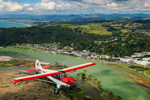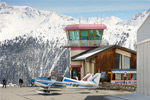This year, AOPA staff toured countries working to build a general aviation industry, providing advice to government and industry officials from lessons we’ve learned in the United States. AOPA covered international trade shows in order to bring you the latest information in emerging technology and aircraft, and stepped into the shoes of pilots in other countries to see how the regulations, flying clubs, and other factors influence their flying.
Bahamas

The nearby islands of the Bahamas brought adventure early in the year as AOPA staff and editors joined Greg Rolle, aviation tourism director for the Bahamas government, on a tour of the islands in March. In “Another Day, Another Island”, AOPA Pilot Senior Editor Dave Hirschman provides tips and suggests activities for different islands and explains the eAPIS process for those who are considering flying to the islands. Hosted by the Bahamas Tourism Council, Hirschman traveled with AOPA President Craig Fuller who met with government aviation and tourism officials about ways to improve GA access in the islands.
United Arab Emirates

AOPA President Craig Fuller, who also serves as the president of the International Council of Aircraft Owner and Pilot Associations, traveled to the United Arab Emirates to welcome the newest member of IAOPA and take in the Abu Dhabi Air Expo as a guest of the Abu Dhabi Airports Company. In his blog, Fuller writes that, “local officials are saying that private aviation in the Middle East is expected to experience a 20 percent growth rate.” While at the show, Fuller spoke to officials about the growing need for pilots and the country’s flight training industry. As we have previously reported, AOPA has taken an active role in researching the flight training industry in the United States and providing that data to help flight schools and instructors improve their training programs.
New Zealand

Travel to exotic New Zealand with Hirschman to fly Huskies and soar with gliders in “Magic in the Air”. “Flying in New Zealand feels both familiar and exotic for U.S. pilots. Most of the regulations are little changed from those in the United States; the airplanes themselves are identical (lots of Cessnas and Pipers), airport markings are mostly alike, and voices on the radio speak English,” Hirschman writes. “It’s much different, however, in the dramatic terrain variations, rapidly changing island weather, reliance on VFR flying, unpronounceable places, and altered procedures.”
Germany

If gadgets, aircraft, and new technology tickle your fancy more than breathtaking scenery, join AOPA Editor at Large Tom Horne in Germany for his coverage of AERO Friedrichshafen, Europe’s premier general aviation exhibition. In “Aero fever,”, Horne writes about the Pipistrel Panthera, a four-seat, 202-knot, 1,000-nautical-mile piston single powered by a Lycoming IO-390 engine, Diamond’s new DA52-VII, and more.
China

Craig Spence, secretary general of IAOPA, spoke about GA in China and participated in a fly-in, hosted at an airport that was just 90 days old. Spence shares how the fly-in was similar to popular U.S. fly-ins. Chinese officials have regularly visited AOPA and the FAA over the past few years as they gear up to boost the industry in their country.
South Africa

Watch out for elephants and other wildlife as you tag along with AOPA Editor in Chief Tom Haines on an aerial safari of the African bush in “Flying in the land of elephants”. Haines, along with John and Martha King, got a bird’s-eye view of South Africa after attending the twenty-sixth biennial World Assembly of IAOPA.
Mexico

While participating in a humanitarian flight to Mexico with LIGA International, Hirschman and AOPA Staff Photographer Chris Rose were some of the first to arrive on the scene of a fatal aircraft accident that was participating in the humanitarian event. In “Tragedy in Mexico,”, Hirschman recounts the accident, along with the hard work of the LIGA International volunteer pilots who provide life-saving supplies and transport medical personnel to El Fuerte, Sinaloa.
France

Horne explains how we can take a page from France’s flying handbook in “French lessons”. Aero clubs, the equivalent of flying clubs in the United States, nurture the nation's GA community. The clubs also boast some advanced technology that would be the envy of any flying club or flight school: One aero club’s airplane keys come with fuel cards and work with software from SafetyPlane that tracks time aloft, engine parameters, and even aircraft position via GPS.
Brazil

AOPA Editor-Web Sarah Brown traveled to Brazil, courtesy of Embraer, for a press event to get the scoop on the company’s new 3,000-nm Legacy 500. “The Legacy 500 is the first midsize business jet to use a full fly-by-wire flight control system and feature a six-foot, stand-up cabin with a flat floor,” Brown wrote. Brown and other reporters got a sneak peek at the jet before its first flight Nov. 27.
Look for AOPA staff to pop up at new locations around the world in 2013. Where the news is, we’ll be there, bringing you the latest on the status of GA around the world, as well as new aircraft and products emerging from other countries.


